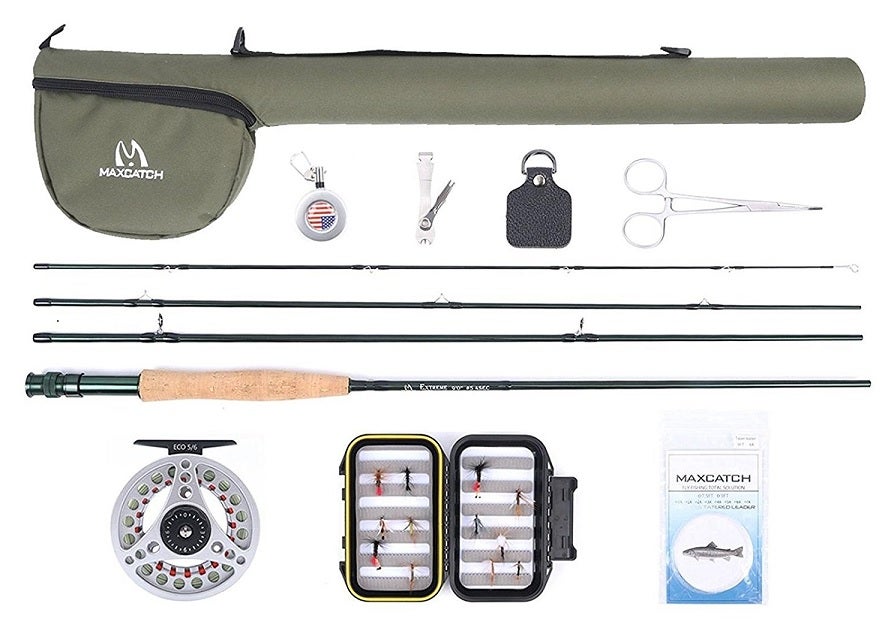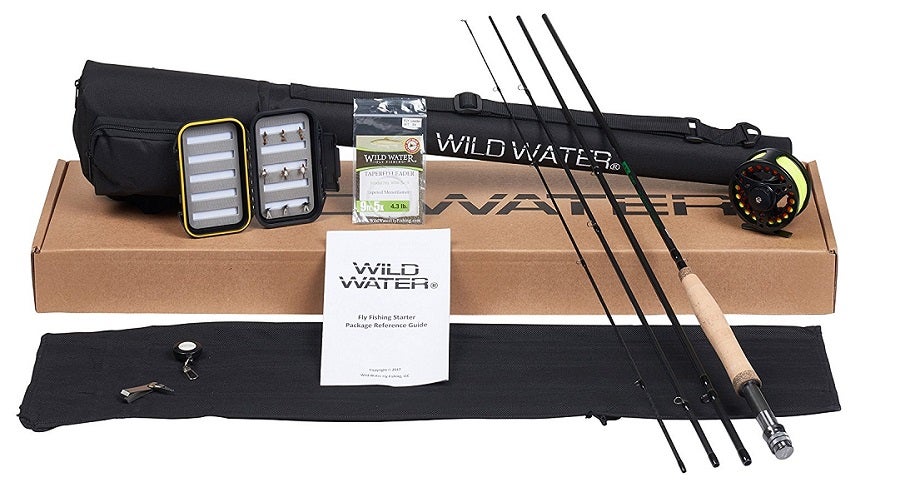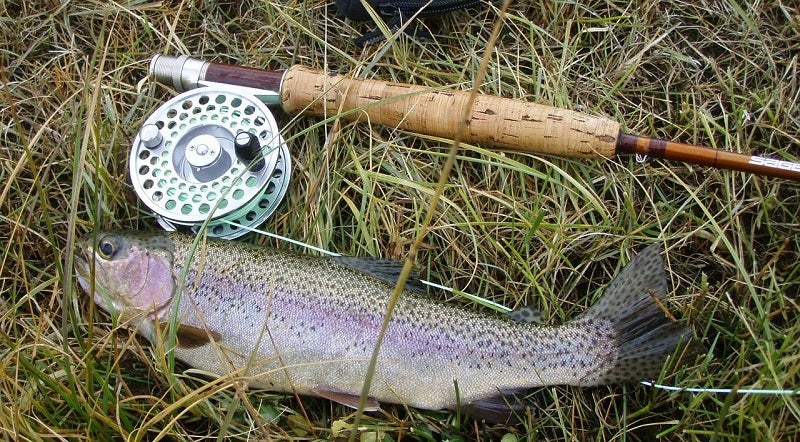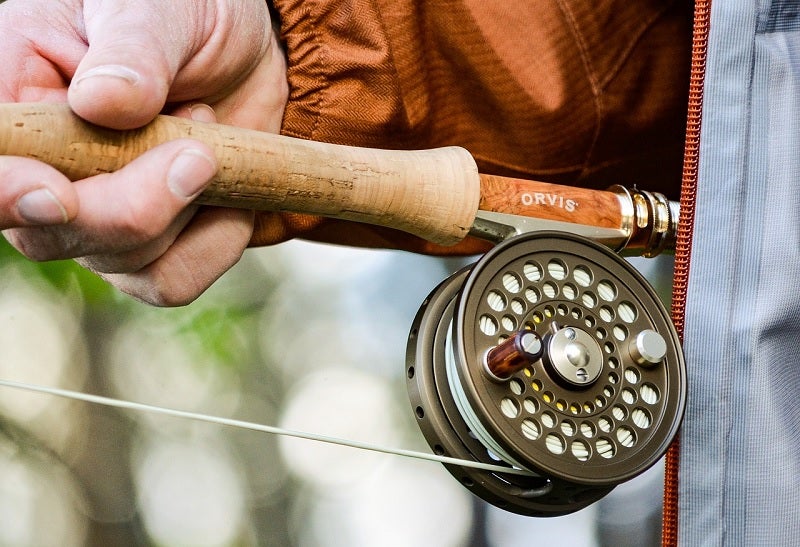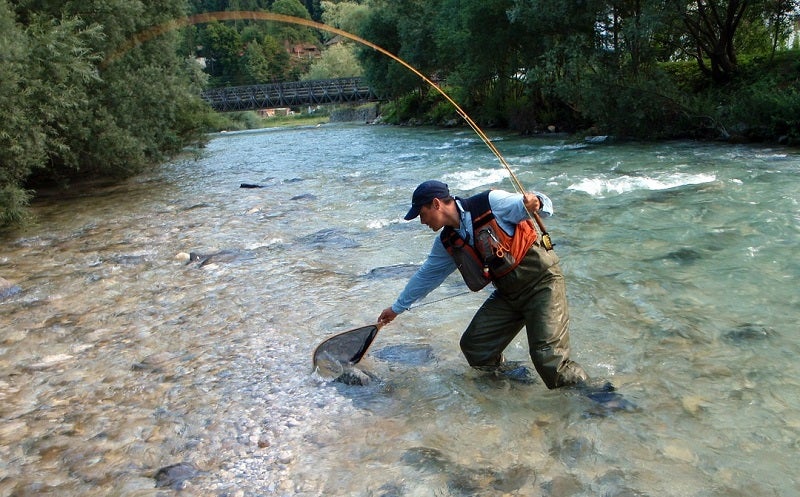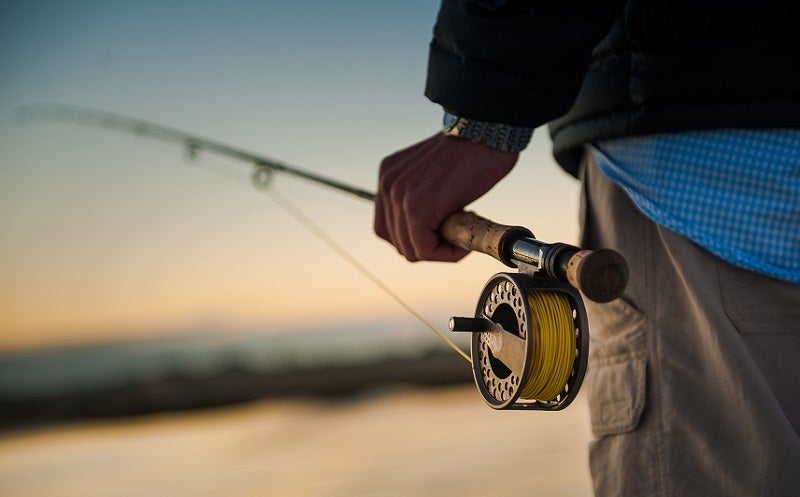
Our Editors independently research, test, and rate what we feel are the best products. We use affiliate links and may receive a small commission on purchases.
Learning to fly fish was the best thing that’s happened for my fishing since my dad first took me out as a kid. I learned to fly fish in Wyoming where I was lucky enough to enjoy fishing some of the most remote mountain streams I could have imagined. If you’re like me then you’ve already been bitten by the fly fishing bug. Or perhaps you’re itching to get started. Choosing the best fly fishing rod can be a challenge for newer anglers. There’s a lot to know and often the details seem out of grasp, like they only really matter to the pros. Fortunately I’m going to help you figure out how to choose the right fly fishing rod for you. We’ll cover what to look for when picking a good fly fishing rod and what to avoid. By the end of this guide you’ll be ready to make your pick!
Best Fly Rods
For more of my fishing gear recommendations, have a look through these popular Outside Pursuits guide links: Fly Reels, Waders, Vests, Wading Boots.
Quick Answer: The 5 Best Rated Fly Fishing Rods For 2021
- Maxcatch Extreme Fly Fishing Combo
- Maxcatch Extreme Graphite Fly Fishing Rod 4-Piece
- Tailwater Outfitters Toccoa Fly Rod
- Wild Water Fly Fishing Complete 5/6 Starter Package
- Orvis Encounter 8-weight 9′ Fly Rod Outfit
Our reviews of the top rated fly rods with our guide and comparison table will help you choose the right one for you.
Fly Fishing Rod Reviews
#1 Maxcatch Extreme Fly Fishing Combo
- Rod, reel, line, case, and accessories
- 5 weight rod, reel, and line
- 9’ long fly rod
By far the top pick on our list of the best fly fishing rods for the 2019 season is the Maxcatch 9’ combo. It’s a great mid-weight combo setup with everything you need to get started.
For a price anyone can agree with, you’ll get started with an awesome do-it-all fly rod.
This rod is a medium-fast action rod with a 9’ overall length. That means it’s going to be on the long and powerful side of the spectrum.
Because it’s a 5 weight rod setup it will be good for moderate bass, trout, and other larger fish. It might take some of the fun out of landing smaller fish.
I like that the fly reel comes pre spooled with line and tippet, ready to go right out of the box. You’ll get a rod case, clippers, hemostats, fly box, and a few flys.
Of course, if you already have all the beginner gear, the combo kit won’t appeal to you as much. Go on to our next pick for just the rod.
Overall this makes an amazing gift for a beginner fly fisher. I wish the action were a bit slower to make it ideal for beginners, but with a little practice I’m sure anyone can master this fly rod and reel combo kit.
Overall I think this is the best fly fishing combo!
Best For: A do-it-all setup or a gift for new/beginner fly fishers.
#2 Maxcatch Extreme Graphite Fly Fishing Rod 4-Piece
- Available in 6 weight / length combos
- Carbon fiber construction
- Medium – fast action
Without a doubt, this rod is one of the best “bang for the buck” fly fishing rod buys you can make today.
With a price that just can’t be argued with and superstar user feedback this is our top pick for buying just the fly fishing rod. Keep in mind you’ll still have to get a matching reel and line.
Unfortunately there’s not a great short slow action rod in this lineup. These are exclusively mid-long rods with mid-fast action feels.
Since this rod is available in up to 6 different combinations you’ll be able to easily pick out the right rod for your needs. If you’re planning to fish mid to larger game fish these rods are a great match for your casting.
I also have to say that I really like the light green coloration on the aluminum rod handle.
If you want to be able to hand pick the right rod for your needs and your budget is a concern you probably won’t find a better option than the Maxcatch Extreme rods.
While they may not achieve some of the bleeding edge performance of top end rods, they will leave money in your wallet and a smile on your face while you land your catch.
Best For: A blend of quality and affordability making it the best fly rod.
#3 Tailwater Outfitters Toccoa Fly Rod
- Available in 3, 5, and 8 weight
- Graphite construction
- Fast action
This is another rod only choice for those who want to tailor their fly fishing setups. Remember that you’ll still need to match the reel and line to the rod.
This fast action graphite rod is a medium length 8’ 4” and comes in several weights to meet your needs.
Maybe not the best choice for a beginner, this fly rod is ready for experienced anglers to slay some fish. The fast action means tons of power in the cast.
With a mid-length rod that means you’ll get a balance of power, casting distance, and versatility.
I like that the rod includes double lock rings for the reel. Nothing is more annoying than having a ring back itself off so you have to constantly tighten it back up. Boo!
There’s a nice four-compartment tube included with this set which means you can easily toss the rod in. Cases are a must have for traveling both in the car and on the trail while you’re walking in to your spot.
These rods are too delicate and expensive to leave unprotected. Overall it’s a good choice for those looking to cast a fast action rod in short to mid lengths and weights.
Of course fast action in short lengths and short weights doesn’t make a whole lot of sense, but there may be times when fishermen want that combination.
Best For: A true fast action rod in mid lengths and mid weights making it a top contender for the best fly fishing rod!
#4 Wild Water Fly Fishing Complete 5/6 Starter Package
- 5/6 weight slow action rod
- Combo includes rod, reel, case, line, and accessories
- Great beginner kit or small stream fishing setup
Of all the fly rod and reel combination kits on our list, I like the case that comes with the Wild Water package the best.
This slow action, mid flex rod is forgiving to beginners and sports a 5/6 weight rod and reel that make it a solid all around choice for new anglers.
This is the first true slow action rod on our list. That means it’s great for small streams and gently casts. The slow action rods are also uniquely forgiving to beginners.
Because the rod is a 5/6 weight it will be good for everything from large bass to small panfish.
Of course lightweight fish might not be as “playful” as they would on a lighter weight rod and huge bass might be a bit too much. But hey, we can’t have everything!
The ideal angler for this kit is fishing in smaller streams or is a beginner fly fisherman. Because of the lighter line and slow action rod it will take a bit more effort than other rods on our list if you want to get those longer casts in.
Best For: Getting yourself a complete fly rod and reel combo for fishing small streams.
#5 Orvis Encounter Fly Rod Outfit
- 8 weight rod and reel
- Preloaded with line, ready to fish
- 9’ rod length
For the last pick on our list I’ve gone with a fly rod and reel combo by the legendary Orvis brand.
Orvis is one of the biggest names in fly fishing and they’re bringing us a mid-fast action rod that’s ready to land some big fish!
This 4 piece rod comes in at a full 9’ length but breaks down into a short 4 piece combo. Unfortunately there isn’t a case with this rod so you’ll definitely want to pick one up extra.
Orvis is known for their top of the line equipment, but the Encounter series is meant to bring performance at a budget. Weight-forward line is pre-strung on the reel and includes backing and a leader.
One thing that I like about the Orvis Encounter rods is that the butt end of the rod is cork covered.
For those that like to grip behind the reel when landing a fish, this makes the process a bit more comfortable and gives you a larger section to really control in the hand.
Overall this rod is best suited for powerful casts in big streams or rivers where you’re expecting to land some large fish. The mid-fast action and 8 weight line mean you should be expecting to haul in a few nice size fish!
Best For: Powerful casts in large water where the goal is landing some big ones!
Fly Rod Comparison Table
| Fly Rod | Includes Reel? | Length | Weight | Includes Case | Rating | |
|---|---|---|---|---|---|---|
| Maxcatch Extreme Fly Fishing Combo | Yes, 5/6 wt Reel | 9 ft | 5 wt | Yes | 4.6 / 5.0 | |
| Maxcatch Extreme Graphite Fly Fishing Rod 4-Piece | No | 6 sizes available from 8' 4" - 9ft | 3/4 wt to 10 wt | Yes | 4.7 / 5.0 | |
| Tailwater Outfitters Toccoa Fly Rod | No | 8’ 4” | 3, 5 and 8 wt | Yes | 4.7 / 5.0 | |
| Wild Water Fly Fishing Complete 5/6 Starter Package | Yes, 5/6 wt Reel | 9 ft | 5/6 wt | Yes | 4.7 / 5.0 | |
| Orvis Encounter Fly Rod Outfit | Yes, 8 wt Reel | 9 ft | 8 wt | No | 4.3 / 5.0 |
How to Choose the Best Fly Rod – Buyers Guide
- Deciding What You Will Fish For
- Fly Rod Action Explained
- Slow Action Fly Fishing Rods
- Fast Action Fly Fishing Rods
- Fly Line Weight
- How to Choose Fly Fishing Rod Length
- FAQs About Fly Fishing Rods
- How to Cast a Fly Rod
- Conclusion
Let’s take a look at some of the most critical buying factors that matter when you’re picking out that fly rod.
Deciding What You Will Fish For
Figuring out exactly what you’re going to try to catch is the most important factor in picking out a fly fishing pole.
Yes, there are other factors at play when deciding on a fly rod but more than any other, having a target fish in mind is helpful to narrow down your pick.
If you’re not sure, do some research. A little research will tell you quickly what types of fish are commonly available in the areas around you, or in the area you plan to visit.
If you’re planning to land a few fat bass you’ll need a completely different rod than you’d want to use for landing a couple small rainbow trout. Of course there’s always the desire to get one rod to do it all.
The proverbial one-rod-quiver. It’s possible to get a single rod that will fish decently for more than one fish, but the more accurate your rod is for the fish you’re targeting the better experience you’ll have.
Fly Rod Action Explained
Every sport needs fancy words to explain general concepts. In archery the spine of the arrow refers to how flexible an arrow shaft is. In fly fishing the rod action refers to how stiff or flexible the rod is along its length.
Fly rod action is measured exclusively on the backswing, called backcast in angler terms. It measures how far the rod bends during this portion of the cast arc. There is no scientific measurement for it, it’s purely an empirical term.
Action is measured from slow to fast, with almost every imaginable combination in between. Another way to think about it is soft to stiff. The softer, or more flexible the rod, the slower the action is.
Slow action rods are very flexible throughout the entire rod. Fast action rods are very stiff yet flexible only near the tip of the rod.
Each type of fly fishing pole action is advantageous for certain situations.
Slow Action Fly Fishing Rods
Slow action, remember, means flexible. These rods are comparatively the most flexible type of fly fishing rods throughout most of the length of the rod.
A slow action rod should reach a nearly right angle bend on the back cast. These rods bend slowly and gracefully across most of their length with the first foot or so being relatively stiff and straight.
Flexible fly rods like slow action rods are good for:
- Beginners
- Small fish
- Small streams or bodies of water
For beginners a slow action rod is nice because it’s the easiest to learn on. The skill level needed to master a slow action rod is a bit lower than what it might take to master a very stiff fast action rod.
When fishing for smaller catches a slow action rod makes for a more fun “fight”. You’ll have to work a bit harder to land those smaller fish and the process is just more fun!
Slow action rods are also nice for smaller bodies of water because you can get a good cast presentation. Stiff rods are hard to use in smaller space and tend to have too much power to be usable on small streams.
Fast Action Fly Fishing Rods
These stiff beasts only bend near the tip on the back cast. They’re a bit harder to master when compared to slow action rods. However, they pack tons of power and are much more suited to certain situations than a slow action rod.
When casting a fast action rod only the tip will bend slightly. This bend comes with tons of power in the cast and, once mastered, is like a rocket launcher compared to a slow action rod.
Fast action rods are good for:
- Large bodies of water
- Longer casts
- Landing larger fish
Because a fast action rod has more power than a slow action rod, they make ideal choices for long casts. Larger rivers, or open bodied of water are great places to take advantage of a fast action rod.
Fast action rods can also handle heavier fish with more precision. Catching small fish on a fast action rod, however, can feel “unsporty” as it becomes quite easy to overpower a small fish with stiff rod.
Of course perfecting the cast and learning how to take advantage of the whippy cast of a fast action rod takes some time. Beginners may struggle timing the cast while even experts will find fast action rods hard to cast on smaller streams.
Fly Line Weight
This is another confusing point of understanding what fly rod to purchase. Each fly fishing pole is meant to work well with a certain range of fly lines. Line is the key component to a good cast with any fly rod, because it’s the line that does most of the work during the cast, not the fly itself.
You need to make sure that the fly rod you’re buying will work well with the weight of line that you plan to use. So what weight line do you use?
Well, if you don’t already know what weight to use you’ll want to review below guide. Once you know what weight you’d like to use based on how you’ll be fishing then you can find a rod that matches!
Figure out what weight line you’ll want to use before deciding on a rod!
As a note, the weight of fly line you want to use is also important in choosing a reel. Rods often come in packages with a matching reel that is appropriate for the same line weight as the rod itself. If you’re buying the rod and reel separate, be sure they match!
Quick Guide to Choosing Line Weight:
| Line Weight | Best For | |
|---|---|---|
| Fly Line Weight 1-3 | Panfish or very small trout | |
| Fly Line Weight 4 | Panfish, large trout | |
| Fly Line Weight 5 | Probably the best "all around" line weight for trout and small bass | |
| Fly Line Weight 6 | Good "all around" line weight for large trout and large bass | |
| Fly Line Weight 7 | River fishing for powerful fish such as bass, salmon and steelhead | |
| Fly Line Weight 8+ | Large powerful saltwater salmon species |
How to Choose Fly Rod Length
This one is important, but easy to figure out. Mostly there are lengths ranging around the 8-9 feet area. Erring on any side of this isn’t the end of the world but getting it right means having a fly rod that works best for you!
Basically the longer the rod, the more power and distance you’ll get out of your casts. The shorter the rod, the easier it will be to cast and control in small streams. It’s that simple.
- 5ft Rods are great for a happy medium of all-around fishing
- 8ft Rods are excellent for smaller streams and short casts
- 9ft Rods are great for tons of power.
FAQs About Fly Fishing Rods
Q: What’s the best all around fly rod?
A: It’s a sensible question. With so many types of fly rods and a limited budget, most people naturally want to find the best “all around” fly fishing rod.
For better or worse, this question can be a bit hard to nail down.
One of the biggest factors in my opinion is your budget. Decide how much you want to spend before you start digging around for details. Don’t let yourself get talked out of your budget.
After that, of course, the exact rod depends on what kind of fish you’re fishing and your preferences. I’ll assume that you don’t have preferences yet, or that you’re buying your first rod.
Many people will tell you that a 5-6 wt fly rod is an ideal mid-range rod that can land large and small fish alike. I happen to agree with this camp and would urge you to start looking in this range for an “all arounder”.
If you’re not sure about length, just go with a 9ft rod but make sure it breaks down small enough that you can easily transport it!
Q: Can I modify the line weight for the rod I have?
A: Honestly there’s not a lot of reason to do this. If you have a 4wt rod just use 4wt line.
Line mostly depends on the size and type of fly you’re casting. Rod weight depends on line weight. That’s just how it goes.
Each rod is made specifically to handle and cast a very narrow band of line weight. Going heavier or lighter can dramatically impact cast performance in a bad way. Don’t do it.
If you go with a relatively “general” rod weight like we talked about above, you should be able to get away with using the same rod and line weight in a variety of situations. As you improve, you’ll probably buy more rods for specific situations so you won’t need to mix and match.
Just remember there’s no need to buy one of every rod weight right out of the gate!
Q: Can I use any rod for saltwater?
A: You can, indeed! However, you need to take care of it.
If your rod is not designated as a saltwater rod, it may contain materials that can be damaged by saltwater. Steel and stainless steel both are susceptible to saltwater corrosion and even un-coated aluminum can be affected.
Usually a coated aluminum such as anodized aluminum is used to help protect saltwater reels.
To take care of a rod after it has been used in saltwater rinse it down gently with tap water from the sink or hose. If you do choose to use a freshwater rod in saltwater, be sure to clean and dry it thoroughly and immediately!
When possible, if your budget allows, try to buy a saltwater specific rod for those trips to the salty expanses of water to avoid any problems!
Q: How do I balance my fly rod?
A: Fly rods are long but lightweight tools we use and their balance is key to good performance. While some fly rods are insanely lightweight, others have a little more beef to them. This depends heavily on the length and material of the rod you’re using.
On the other hand, reels can vary from super-lightweight to moderately heavy. So, does it matter how much each pieces weighs? If so, how do you find the right combination?
Turns out that your reel for any given fly rod should ideally balance the rod. That means the weight of the reel offsets the weight of the rod when held in your hand.
To find out if your rod is balanced, hold the grip in your hand. Slowly open your fist until you have a single finger on the rod. Adjust that finger up and down the rod to find the balance point.
If your balance point is in the middle of the handle, you’ve got a balanced rod! If you open your hand and the rod tips out of your hand forward, then it’s tip heavy – you may benefit from a beefier reel. If your rod tips out of your hand to the back, your reel is too heavy! Try lightening up for a better cast.
Q: What rod should I use to get shorter casts?
A: So often we get focused on casting long distances, and many times this is a great skill to have. Sometimes, however, your local fishing area might not be big enough to need a cast that long. On top of that, using a long-casting rod can be almost impossible to cast short.
If you want to go a bit shorter on your casts, try this.
Look for a slow action rod (lots of flex) that’s on the short end to make short casts easier. If you’re staying under 30ft of casting distance a 5.5’ or 6.5’ rod should get you in the sweet spot!
So next time you’re trying to land a nice precise cast in a hole that’s up close, you’ll want to rely on these slow action, short rods. Stop fumbling with such a long rod for short casts and you’ll find it much easier to be consistent.
How to Cast a Fly Rod
Final Thoughts
Ultimately there are more combinations of fly rod length, weight, and preferences than we can possibly list in a single article. Above you’ll find all the details you need to know to make an intelligent buying decision on your next fly fishing rod.
Plus, I’ve included some of my favorite fly fishing rods that you can buy to get started right now!
When you’re ready to get serious, just browse through what I think are some of the best fly fishing rods for your money right now. Pick the one that best suits your needs, and get out there landing fish!
As you learn and grow you’ll probably develop your own opinion and understanding of what fly rods are the best. Over time you may even end up with a whole closet full of rods!
How We Researched
To come up with the top fly fishing rods we researched a variety of sources for reviews such as REI, Dicks Sporting Goods and Bass Pro Shops along with our own personal experience.
We also consulted online magazines for product research and reviews to get as much unbiased information as we could. To help weed out fake reviews we used Fakespot.com to make sure we only looked at genuine reviews.
With so much quality gear available, we had to narrow it down based on what we felt were the best options for the price. The author, Casey Fiedler has been an avid fisherman for decades and leads fishing trips into the backcountry.
To help narrow down the selection our authors used their personal experience along with recommendations from charter captains and tour guides.
After extensive research, we came up with our list to help you choose the right one for you.
Sources

